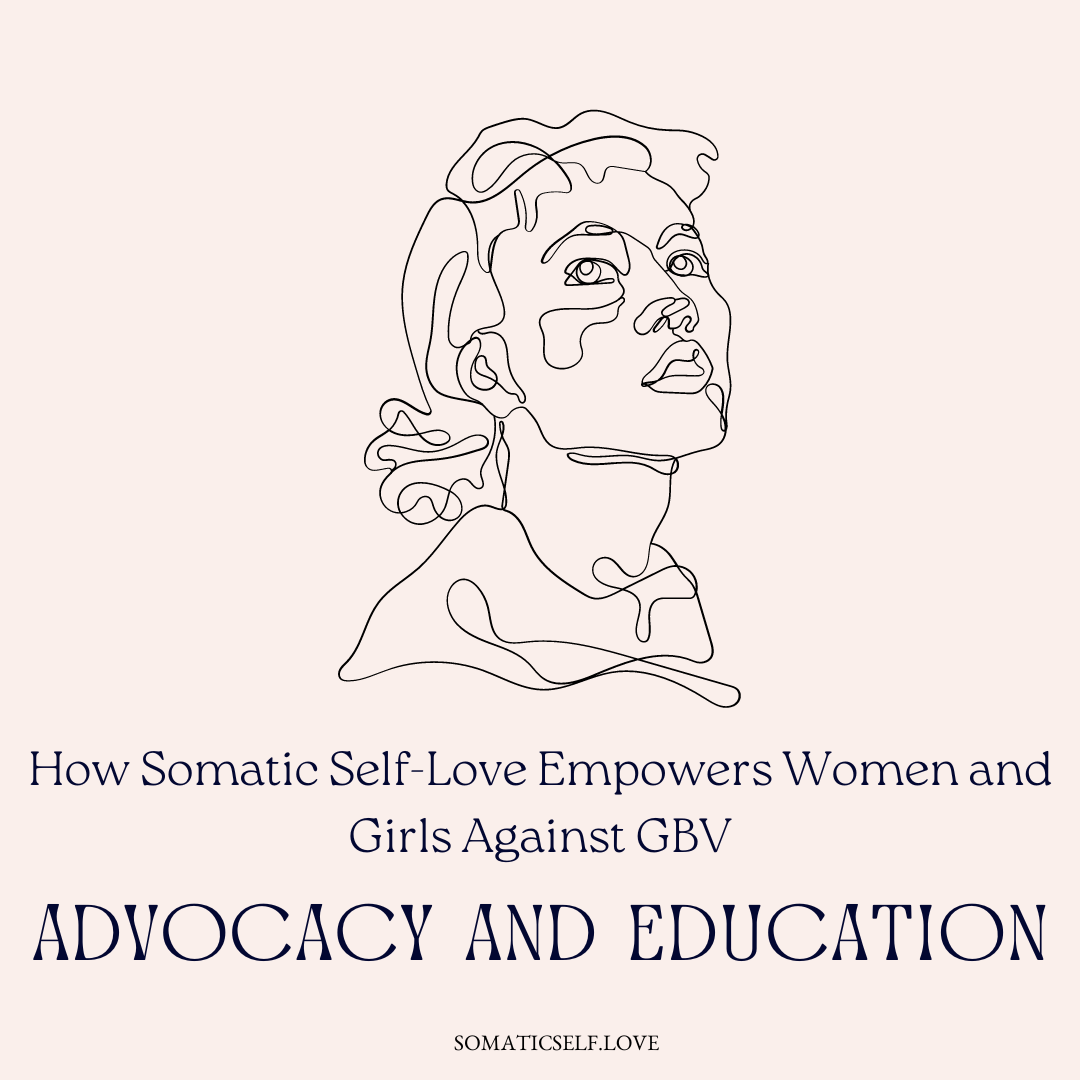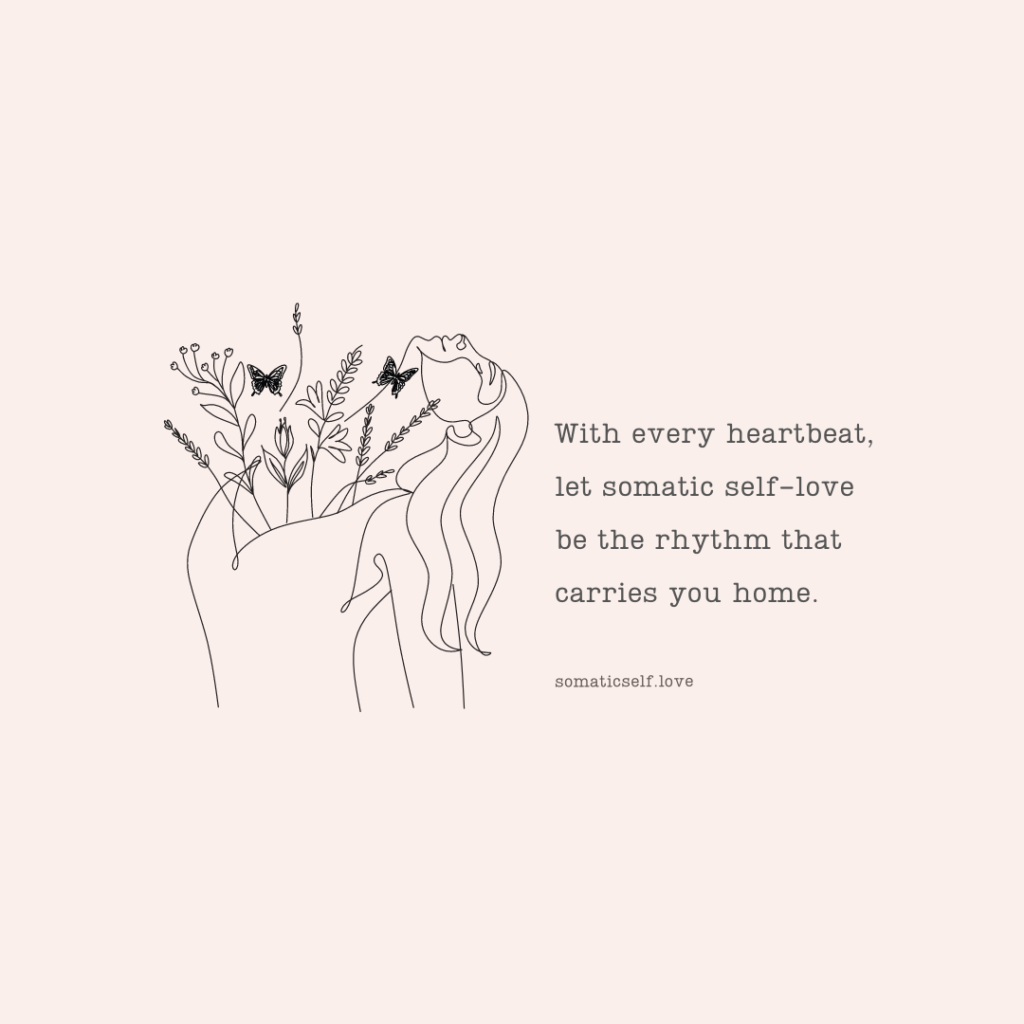Somatic Self-Love and its Role in Empowering Women and Girls Against Gender-Based Violence

Gender-based violence (GBV) is a pervasive and devastating issue that affects millions of women and girls around the world. It takes many forms – including sexual, physical, and emotional abuse – and has far-reaching consequences for individuals, families, and communities.
As we collectively strive to end GBV within the next two generations, it’s crucial to explore effective tools and techniques for fostering empowerment, resilience, and healing among survivors. One such approach that holds great promise is Somatic Self-Love – a holistic practice that emphasizes body-based healing and self-compassion. In this blog post, we’ll delve into the foundations of Somatic Self-Love and discuss how it can play a vital role in empowering women and girls against GBV.

The Power of Self-Love and Self-Compassion
At the core of Somatic Self-Love is the belief that nurturing self-love and self-compassion is crucial for personal growth, healing, and empowerment. Research has consistently shown that self-compassion is associated with lower levels of anxiety, depression, and stress, as well as greater resilience and overall well-being1. For survivors of GBV, cultivating self-compassion can serve as a powerful tool in the healing process, enabling them to move beyond feelings of shame or self-blame and instead embrace self-kindness, understanding, and forgiveness.
How Somatic Self-Love Empowers Women and Girls Against GBV
Somatic Self-Love combines elements of mindfulness, body awareness, and emotional expression to foster a deep, loving connection with oneself. By focusing on the body as a source of wisdom and strength, this practice can help women and girls develop a greater sense of self-worth, self-confidence, and assertiveness – all of which are essential for standing up against GBV. Here are some key ways in which Somatic Self-Love can contribute to empowerment and healing:
- Reconnecting with the body: Many survivors of GBV experience disconnection from their bodies due to trauma, fear, or shame. Somatic Self-Love practices, such as grounding exercises, breathwork, and movement, can help individuals reestablish a sense of safety and trust in their bodies, which is essential for healing and self-empowerment2.
- Emotional regulation and resilience: Somatic Self-Love can teach women and girls to recognize, accept, and express their emotions in a healthy and constructive manner. This, in turn, can enhance their ability to cope with stress, trauma, and adversity, making them more resilient and better equipped to stand up against GBV3.
- Building self-confidence and assertiveness: By cultivating self-compassion and self-worth, women and girls can develop the confidence to assert their boundaries, speak up against abuse, and advocate for their rights. Somatic Self-Love practices, such as affirmations and self-compassion meditation, can be instrumental in fostering these qualities4.
- Creating safe spaces for healing and growth: Somatic Self-Love encourages the formation of supportive communities where women and girls can openly share their experiences, learn from one another, and collectively work towards healing and empowerment. This sense of belonging and mutual support can be invaluable in the fight against GBV5.
Conclusion
Somatic Self-Love offers a promising path for empowering women and girls against gender-based violence, helping them cultivate self-worth, resilience, and assertiveness while fostering healing and personal growth. As we work towards a world free from GBV, it’s essential to embrace and promote practices like Somatic Self-Love that uplift and strengthen the individuals and communities most affected by this devastating issue.
Footnotes
- Neff, K. D. (2003). Self-compassion: An alternative conceptualization of a healthy attitude toward oneself. Self and Identity, 2(2), 85-101. ↩
- van der Kolk, B. (2014). The body keeps the score: Brain, mind, and body in the healing of trauma. Penguin Publishing Group. ↩
- Tull, M. T., Gratz, K. L., & Chapman, A. L. (2016). The role of emotion regulation in the presence and prediction of emotional numbing in survivors of trauma. In Emotion Regulation and Psychopathology (pp. 65-87). Routledge. ↩
- Neff, K. D., & Germer, C. K. (2013). A pilot study and randomized controlled trial of the mindful self-compassion program. Journal of Clinical Psychology, 69(1), 28-44. ↩
- Ullman, S. E., & Peter-Hagene, L. (2016). Social reactions to sexual assault disclosure, coping, perceived control, and PTSD symptoms in sexual assault victims. Journal of CommunityPsychology, 44(4), 495-508. ↩
Your Support Matters: Help Us Empower More Lives!
Are you enjoying the transformative power of our free Somatic Self-Love Toolkit? If it has touched your life, we invite you to help us spread the love and healing even further.
By donating to our nonprofit, Alchemy By Love, you directly contribute to our mission of empowering and healing individuals through the power of somatic self-love.
Your support allows us to continue providing invaluable resources and life-changing tools, like the Somatic Self-Love Toolkit, to those in need.
Join us in creating a world where everyone can experience the transformative magic of somatic self-love. Every contribution counts! 💖🤝🏽
Make a difference today…
Are You Enjoying the free Somatic Self-Love Toolkit? Help us! You can donate to the Nonprofit, Alchemy By Love!